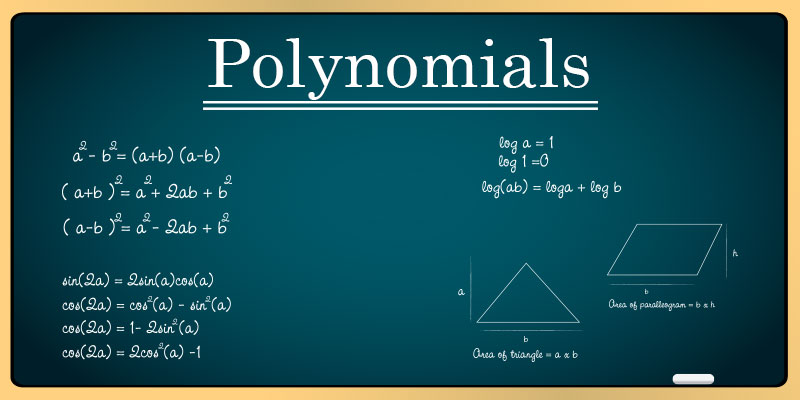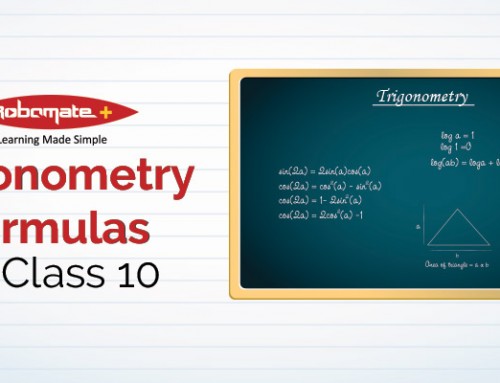CHAPTER – 2 : Polynomials
DEGREE OF A POLYNOMIAL:-
If p(x) is a polynomial in x, the highest power of x in p(x) is called the degree of polynomial p(x).
And expressions like:- x2−−√+2,1x−1etc., are not polynomials.
Example-1:
3x4+2x2+6x = 1, the highest power of the given polynomial equation is 4
Therefore, its degree is 4.
Example-2:
x5y3z + 2xy3+4x2yz2
This equation is of multiple variables (x, y, z) and to find the degree of this equation, we just need to add up the degrees of the variables in each of the terms and also it does not matter whether they are different variables.
Therefore, 1st term (5+3+1), 2nd term (1+3) and 3rd term (2+1+2).
The highest total is 9, of the 1st term,
Therefore, its degree is 9.
Polynomial equation with degree 1 is called a linear polynomial.
Example: x – 3–√ = 0
Polynomial equation with degree 2 is called a quadratic polynomial.
Example: x2+2–√x+7=0.
Polynomial equation with degree 3 is called a cubic polynomial.
Example: 3x3–5x2+7–√x+5–√=0.
Factorization of a quadratic polynomial equation by splitting middle term:-
General form of quadratic polynomial equation:- ax2 + bx + c = 0
Step 1:- Find the product of a (first term) and c (last term).
Step 2:- Then split the product of a and c into two numbers such that their product remains same as (a × c) and their sum or difference is equal to the value of b (middle term).
Step 3:- Now, there will be total four terms in the equation, make two groups with each group having two terms each. Then take whatever is common and equate it to 0, the resultant values of x will be factors of the quadratic equation.
Example:
12 x2 = -11x +15
Solution:
12x 2 + 11x -15 = 0 (product of a and c is 12×15=180)
12x 2 + 20x – 9x -15 = 0 (splitting 180 into 20 and 9 such that, 20 – 9 = 11 and 20×9 = 180).
4x(3x + 5) – 3(3x + 5) = 0
(4x -3)(3x + 5) = 0
4x – 3 = 0 or 3x + 5 = 0
4x = 3 or 3x = – 5
x = 34 or x = −53
Therefore, solution of this quadratic equation is (−53, 34 ).
This solution is called zeroes or roots of the given polynomial.
EXERCISE 2.1
Graphical method to find zeroes:-
Total number of zeroes in any polynomial equation = total number of times the curve intersects x-axis.
Example 1:-

In the above graph, the curve intersects x axis at A and B.
Therefore, the equation of the curve will have maximum of 2 zeroes.
Example 2:-

From the above graph, the curve cuts the x-axis at point A
Therefore, number of zeroes of p(x) = 1
Example 3: –
From the above graph, the curve p(x) intersects x-axis at points A, B and C.
Therefore, the number of zeroes of polynomial equation is 3.

Zeroes and Coefficient of a polynomial:
If α and β are zeroes of any quadratic polynomial ax2 + bx + c=0,
Then, Sum of zeroes = α+β = −ba
Product of zeroes = αβ = ca
If α and β are zeroes of any quadratic polynomial, then the quadratic polynomial equation can be written directly as:
x2 – (α + β)x + αβ = 0
EXERCISE 2.2
Q.1 Find the zeroes of the following quadratic polynomials and verify the relationship between the zeroes and the coefficients.
(i) 6x² + 11x + 5 = 0
Soln: –
6x2 + 11x + 5 = 6x2 + 6x + 5x + 5
= 6x(x +1) + 5(x +1)
= (x +1) (6x +5)
∴ zeroes of polynomial equation 6x2 +11x +5 are { −1, −56 }
Now, Sum of zeroes of this given polynomial equation = −1+( −56 ) = −116
But, the Sum of zeroes of any quadratic polynomial equation is given by = −coeff.ofxcoeff.ofx2
= −116
And Product of these zeroes will be = −1×−56 = 56
But, the Product of zeroes of any quadratic polynomial equation is given by = constanttermcoeff.ofx2
= 56
Hence the relationship is verified.
(ii) 4s2 – 4s + 1
Sol:
4s2 – 4s + 1 = 4s2 – 2s – 2s + 1
= 2s (2s – 1) –1(2s – 1)
= (2s – 1) (2s – 1)
∴ zeroes of the given polynomial are: {12,12}
∴ Sum of these zeroes will be = = 1.
But, The Sum of zeroes of any quadratic polynomial equation is given by = −coeff.ofscoeff.ofs2
= −44 = 1
And the Product of these zeroes will be = 12×12
=14
But, Product of zeroes in any quadratic polynomial equation is given by = constanttermcoeff.ofs2
= 14.
Hence, the relationship is verified.
(iii) 6x2 – 3 – 7x
Sol:
6x2 – 7x – 3 = 6x2 – 9x + 2x – 3
= 3x (2x – 3) +1(2x – 3)
= (3x + 1) (2x – 3)
∴ zeroes of the given polynomial are: – (−13,32)
∴ sum of these zeroes will be = −13+32
=76
But, The Sum of zeroes in any quadratic polynomial equation is given by = −coeff.ofxcoeff.ofx2
= 76
And Product of these zeroes will be = −13×32=−12
Also, the Product of zeroes in any quadratic polynomial equation is given by = constanttermcoeff.ofx2
= −36 = −12
Hence, the relationship is verified.
(iv) 4u2 + 8u
Sol:
4u2 + 8u = 4u (u+2)
Clearly, for finding the zeroes of the above quadratic polynomial equation either: – 4u=0 or u+2=0
Hence, the zeroes of the above polynomial equation will be (0, −2)
∴ Sum of these zeroes will be = −2
But, the Sum of the zeroes in any quadratic polynomial equation is given by = −coeff.ofucoeff.ofu2
= −84 = −2
And product of these zeroes will be = 0 × −2 = 0
But, the product of zeroes in any quadratic polynomial equation is given by = constanttermcoeff.ofu2 = −04 = 0
Hence, the relationship is verified.
(v) t2 – 15
Sol:
t2 – 15 = (t+ 15−−√) (t − 15−−√)
Therefore, zeroes of the given polynomial are: – {15−−√, −15−−√}
∴ sum of these zeroes will be = 15−−√ − 15−−√ = 0
But, the Sum of zeroes in any quadratic polynomial equation is given by = −coeff.ofxcoeff.ofx2
= −01 = 0
And the product of these zeroes will be = (15−−√) × (−15−−√) = −15
But, the product of zeroes in any quadratic polynomial equation is given by
= constanttermcoeff.oft2 = −151 = −15
Hence, the relationship is verified.
(vi) 3x2 – x – 4
Sol:
3x2 − x − 4 = 3x2 – 4x + 3x − 4
= x (3x – 4) +1(3x – 4)
= ( x + 1) (3x – 4)
∴ zeroes of the given polynomial are: – {−1, 43 }
∴ sum of these zeroes will be = −1 +43 = 13
But, the Sum of zeroes in any quadratic polynomial equation is given by = −coeff.ofxcoeff.ofx2
= −(−1)3 = 13
And the Product of these zeroes will be = {−1 × 43 }
= −43
But, the Product of zeroes in any quadratic polynomial equation is given by = constanttermcoeff.ofx2
= −43
Hence, the relationship is verified.
Q2. Form a quadratic polynomial each with the given numbers as the sum and product of its zeroes respectively.
(i). 26 , −3
Sol.
Given,
α + β = 26
αβ = −3
∴ If α and β are zeroes of any quadratic polynomial, then the quadratic polynomial equation can be written directly as:-
x2 – (α+β)x +αβ = 0
Thus, the required quadratic equation will be:
x2 – (26)x −3 = 0
6x2 − 2x – 18 = 0.
(ii). 3–√ , 43
Sol.
Given,
α + β = 3–√
αβ = 43
∴ If α and β are zeroes of any quadratic polynomial, then the quadratic polynomial equation can be written directly as: –
x2 – (α+β)x +αβ=0
Thus, the required quadratic equation will be: –
x2 – (3–√)x + 43 =0
3x2 − 33–√x + 4 = 0.
(iii). 0, 7–√
Sol.
Given,
α + β = 0
αβ = 7–√
∴ If α and β are zeroes of any quadratic polynomial, then the quadratic polynomial equation can be written directly as:-
x2 – (α+β)x +αβ=0
Thus, the required quadratic equation will be: –
x2 – (0)x + 7–√ = 0
x2 + 7–√ = 0.
(iv). −2, −2
Sol.
Given,
α + β = −2
αβ = −2
∴ If α and β are zeroes of any quadratic polynomial, then the quadratic polynomial equation can be written directly as:
x2 – (α+β)x +αβ=0
∴ The required quadratic polynomial will be:
x2 – (−2)x −2 = 0
x2 + 2x – 2 = 0.
(v). −72, 39
Sol.
Given,
α + β = −72
αβ = 39
∴ If α and β are zeroes of any quadratic polynomial, then the quadratic polynomial equation can be written directly as: –
x2 – (α+β)x +αβ = 0
∴ The required quadratic polynomial will be:
x2 – (−72)x + 39 = 0
18x2 + 63x + 6 = 0.
(vi). 6, 0
Sol.
Given,
α + β = 6
αβ = 0
∴ If α and β are zeroes of any quadratic polynomial, then the quadratic polynomial equation can be written directly as:-
x2 – (α+β)x +αβ = 0
∴ The required quadratic polynomial will be:-
x2 – 6x + 0 = 0
x2 – 6x = 0.
EXTRA QUESTIONS
Q.1 Find a quadratic polynomial whose zeroes are: –2+12√, 2−12√.
Sol.
Given: –
α + β = 2+12√ + 2−12√
= 4.
αβ = (2+12√)(2−12√)=4−12=72
∴ If α and β are zeroes of any quadratic polynomial, then the quadratic polynomial equation can be written directly as: –
x2 – (α+β)x +αβ = 0
Thus, the required quadratic polynomial equation will be :-
x2 – (4)x −72 = 0
2x2−8x+7 = 0.
Q.2 If α and β are the roots of a quadratic polynomial ax2+bx+c, then find the value of α2 + β2.
Sol.
From the equation, (α+β=−ba)
And, α×β=ca
(α+β)2=α2+β2+(2αβ)
∴ α2+β2=(α+β)2−2αβ
∴ α2+β2=(−ba)2−2ca
∴ α2+β2=b2a2−2ca
∴α2+β2=b2−2aca2.
Similarly, we can find out the values of (α3 + β3) and (α3 – β3).
Q3. If α and β are zeroes of a quadratic polynomial x2+4x+3, form the polynomial whose zeroes are 1+αβand1+βα.
Sol.
Since α and β are zeroes of a quadratic polynomial x2+4x+3,
α+β= -4, αβ = 3
Given: – α1 = 1+αβ
β1 = 1−βα
Now, sum of zeroes = 1+αβ+1+βα
= 2+αβ+βα
= 2αβ+α2+β2αβ
= (α+β)2αβ
On putting values of α+β and αβ from above we get:-
Sum of zeroes = α1 + β1 = −423
= 163
Now, Product of zeroes = (1+αβ)(1+βα)
=1+βα+αβ+αββα
=2αβ+β2+α2αβ
= (α+β)2αβ
On putting values of α+β and αβ we get:
Product of zeroes = α1 × β1 = −423
= 163
Thus the required quadratic polynomial equation will be:-
x2 – (α1 + β1)x + α1β1 = 0
x2 – (163)x + 163 = 0
3x2 – 16x +16=0.
Q4. If α and β are zeroes of a quadratic polynomial p(x) = rx2+4x+4, Find the values of “r” if: – α2 + β2 = 24.
Sol.
From the given polynomial p(x),
α + β = −4r, and αβ = −4r………. (1)
Since,(α + β)2 = α2 + β2 + 2αβ
Given, α2 + β2 = 24 and from equation (1).
Therefore, (−4r)2=24+2×4r
16r2=24+2×4r
16 = 24 r2 + 8r
3r2 + r – 2 = 0
3r2 + 3r – 2r -2 = 0
3r(r+1) – 2(r+1) = 0
(3r-2) (r+1) = 0
∴ r = 23 or r = -1
DIVISION ALOGORITHM
If suppose p(x) and g(x) are any two polynomials with g(x) ≠ 0, then we can find polynomials q(x) and r(x) such that: –
p(x)=g(x) × q(x) + r(x), where r(x)=0 or degree of r(x) < degree of g(x) …….(1)
This is known as the division algorithm for polynomials.
And since, Dividend = Divisor × Quotient + Remainder
On comparing it with equation (1) we can conclude that:
Dividend = p(x).
Divisor = g(x).
Quotient = q(x).
Remainder = r(x).
EXERCISE 2.3
Q.1 If a polynomial x3 -3x2+x+2 is divided by a polynomial g(x), the quotient and remainder obtained are (x-2) and (-2x+4), respectively. Find the equation of g(x).
Sol.
Since, Dividend = Divisor × Quotient + Remainder
Therefore, x³ -3x2+x+2 = g(x) × (x-2) + (-2x+4)
(x3 -3x2+x+2) – (-2x+4) = g(x) × (x-2)
Therefore, g(x) × (x-2) = x3 -3x2+3x-2
Now, for finding g(x) we will divide “x3 -3x2+3x-2” with (x-2)

Therefore, g(x) = (x2 – x +1)
Q.2 Find the quotient and remainder by dividing the polynomial f(x) by the polynomial g(x).
(i) f(x) = x3 + 2x2 – 9x + 5, g(x) = x2+5

Therefore, Quotient is (x+2) and Remainder is (-14x − 5)
(ii) f(x) = x5+2x4-9x3+5x2-2x+1, g(x) = x3 + x2 – x+1

Therefore, Quotient is (x2 + x − 9) and Remainder is (14x2 – 12x +10).
(iii) f(x) = 2x4 + 7x3 + 5x2 + 8x + 5, g(x) = 11− 2x3 + x2

Therefore, Quotient is – (x + 4) and Remainder is (9x2 + 19x +49).
Q3. Find all the zeroes of the polynomial equation 2x4-3x3-3x2+6x-2, if two of its zeroes are 2–√and−2–√.
Sol.
Since this is a polynomial equation of degree 4, there will be a total of 4 roots.
Let, f(x) = 2x4 – 3x3 – 3x2 + 6x – 2
2–√and−2–√ are zeroes of f(x).
∴(x−2–√)(x+2–√)= (x2− 2) = g(x), is a factor of given polynomial f(x).
If we divide f(x) by g(x), the quotient will also be a factor of f(x) with remainder =0.

So, 2x4 − 3x3 − 3x2 + 6x – 2 = (x2 – 2) (2x2 – 3x +1).
Now, on further factorizing (2x2 – 3x +1) we get,
2x2 – 3x +1 = 2x2 – 2x − x +1 = 0
2x (x − 1) – 1(x−1) = 0
(2x−1) (x−1) = 0
So, its zeroes are given by: x= 12 and x = 1
Therefore, all four zeroes of the given polynomial equation are:
2–√,−2–√,12and1.
Q4. Find all zeroes of a polynomial equation x4-6x3-26x2+138x-35, if two of its zeroes are 2+3–√ and 2−3–√.
Sol.
Since this is a polynomial equation of degree 4, hence there will be total 4 roots.
Let, f(x) = x4 – 6x3 – 26x2+ 138x – 35
Since, (2+3–√)and(2−3–√) are zeroes of given polynomial f(x).
∴[x−(2+3–√)][x−(2−3–√)]=0
(x−2−3–√)(x−2+3–√)
On multiplying the above equation we get,
x2 −4x + 1, this is a factor of a given polynomial f(x).
Now, if we will divide f(x) by g(x), the quotient will also be a factor of f(x) and the remainder will be 0.

So, x4 − 6x3 − 26x2 + 138x – 35 = (x2 – 4x + 1) (x2 – 2x −35).
Now, on further factorizing (x2 – 2x −35) we get,
x2 – (7−5)x − 35 = x2 – 7x + 5x +35 = 0
x(x − 7) + 5 (x−7) = 0
(x+5) (x−7) = 0
So, its zeroes are given by: x= −5 and x = 7.
Therefore, all four zeroes of given polynomial equation are:
2+3–√,2−3–√, −5 and 7.
Q5. Find all zeroes of a polynomial equation 3x4 + 6x3 – 2x2 – 10x – 5, if two of its zeroes are 53−−√ and −53−−√.
Sol.
Since this is a polynomial equation of degree 4, hence there will be total 4 roots.
Let, f(x)= 3x4+6x3-2x2-10x-5
53−−√ and −53−−√ are zeroes of polynomial f(x).
∴(x−53−−√)(x+53−−√)
(x2−53)=0
(3x2−5)=0, is a factor of given polynomial f(x).
Now, when we will divide f(x) by (3x2−5) the quotient obtained will also be factor of f(x) and remainder will be 0.

Therefore, 3x4 + 6x3 − 2x2 − 10x – 5 = (3x2 – 5) (x2 + 2x +1).
Now, on further factorizing (x2 + 2x +1) we get,
x2 + 2x +1 = x2 + x + x +1 = 0
x(x + 1) + 1(x+1) = 0
(x+1) (x+1) = 0
So, its zeroes are given by: x= −1 and x = −1
Therefore, all four zeroes of given polynomial equation are:
53−−√, −53−−√, −1 and −1.












